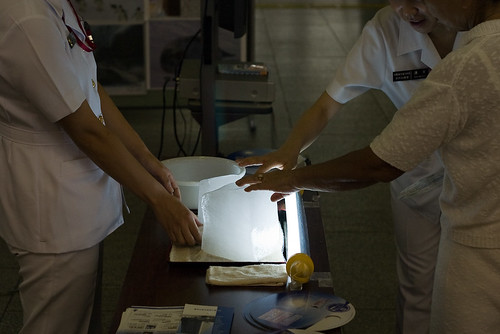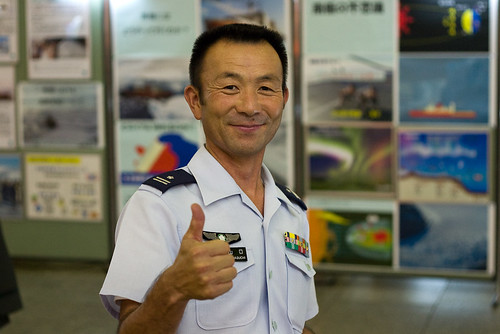Curzon over at Cominganarchy just posted his impressions of his visit to a new Japanese Self Defense Force recruiting center in hip Shibuya (verdict: fail). Just the other day I happened to run into another rather sad attempt at recruiting in Osaka’s Hankyu Umeda Station.

Instead of the ordinary but silly strategy of letting visitors play dress-up, the attraction here was something a little on the bizarre side – a block of ice from Antarctica.

Indeed, it was very cold. The message seemed to be something about how joining the Navy lets you travel to faraway and exotic places, but I’m not sure that a block of ice was the best way to convey that, even with the helpful diagrams explaining how striation in Antarctic ice is different from that which you grow in your own freezer.

I’m not actually quite sure who does join the SDF in Japan. Back in the US I had quite a few friends from high school who either joined the military proper or the reserves, or had simply been ROTC members before graduation, and in college I again knew plenty of people who were either paying for school through the reserves or were getting scholarships from previous military service, but I can’t say I actually know a single person in Japan who is either a current or past member of the postwar military.
In fact, practicaly the only Japanese person I’ve ever met who wanted to join the SDF here was a guy I met briefly in a youth hostel in Beijin when I visited back in 2004 with my then-girlfriend. 20 years old, buzzcut dressed entirely in camo, giant thick glasses, scrawny, and big black combat boots, he was the perfect incarnation of the stereotypical military nerd who wants to be Rambo but would be lucky to even pass the basic training and get a desk job. The military was quite literally the only thing he could discuss, and even the briefest attempts at smalltalk were immediately sidelined into military talk.
One real exchange I remember:
Me: I’m from New Jersey.
Him: East coast right?
Me: Yeah, right by New York City.
Him: New York… That’s where West Point is. And it’s only a few hours drive from the big naval bases in Virginia.
Me: Uhh, yeah… that’s right. We’re gonna go check out that famous Beijing duck restaurant now – see you later.
And speaking of military otaku, the government sponsored Taiwan Journal has a rather interesting look at the niche publiching market of military themed magazines in that country, which look to me rather similar to the same type of periodical in Japan. Of course, in a country where all adult males are drafted (until they complete the ongoing transition to an all volunteer force sometime in the future) you would expect that the average level of knowledge and interest in the subject might be a lot higher.

